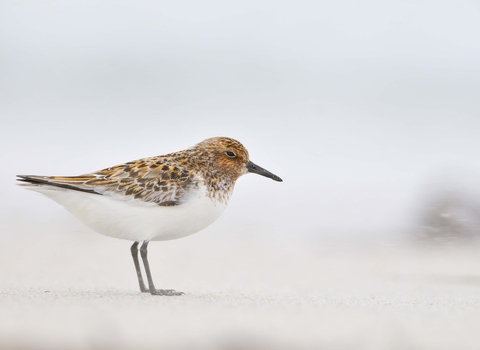
©Chris Gomersall/2020VISION

©Neil Aldridge

©Fergus Gill/2020VISION
Sanderling
The sanderling scampers about the waves looking for marine crustaceans, fish and even jellyfish to eat. It visits the UK in winter from its Arctic breeding grounds, but can also be seen as it passes through on migration during spring and autumn.
Scientific name
Calidris albaWhen to see
August to MayTop facts
Stats
Length: 20-21cmWingspan: 42cm
Weight: 59g
Average lifespan: 7 years
Classified in the UK as Amber under the Birds of Conservation Concern 5: the Red List for Birds (2021).
Habitats
About
The sanderling is a medium-sized sandpiper. It feeds in small flocks at the edge of the tide, scampering back and forth after the waves, looking for insects, crustaceans, worms, fish and even jellyfish. Sanderlings breed in the Arctic, visiting the UK in the winter and passing through on migration during spring and autumn. The distance they travel varies, but individuals have been known to make 32,000 km annual round-trips to their breeding and wintering grounds.What to look for
Similar to the knot, the sanderling is smaller and paler, with a dark patch on the shoulder and with black, rather than green, legs. It is best recognised by its behaviour, scampering about on the beach rather than walking and probing in the mud. In the winter, it is silvery-grey, almost white, with a bright white belly.Where to find
A common winter visitor to our coasts; best looked for on long, sandy beaches.Did you know?
Sanderlings only have three toes on each foot; they are missing the hind toe, which gives them a distinctive running action - a bit like a clockwork toy.Watch
Sanderling (https://vimeo.com/452225430/31ccf5a2ca)
Sanderling by Tom Hibbert
